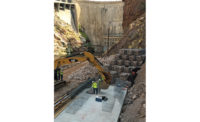After the intake structure at Unit 4 of Horse Mesa Dam suffered a catastrophic failure in summer 2012 when a flow control wall collapsed, owner Salt River Project (SRP) began to make preparations to bring the facility—the largest source of hydroelectric power generation on the Salt River—back to life. A major hurdle, however, was the failure's location 160 ft below the lake's surface. That left just two options for the repair: draining a large majority of Apache Lake's 254,138-acre water capacity or utilizing saturation divers to complete the work.


SRP says it conducted a multitude of studies and research that made it clear that saturation divers could do the job more quickly, while also limiting the economic downside caused to local businesses by a reduction in lake levels.
"None of this could have been possible without the expertise of Stantec and the fabrication skills of SRP's mechanical construction and maintenance department," says Jeff Lane, spokesman for SRP. "Had it been necessary to lower the reservoir in order to make the repairs, the project would have taken two years or more to complete, instead of the 14-month return to service."
The saturation diving work was performed by Global Diving & Salvage and included installation of a new flow control structure for Unit 4. More than 800 individual concrete anchors were installed to secure the structure to the surrounding concrete walls, and more than 1,800 steel fasteners were used to attach the horizontal sections to the new steel vanes.
The replacement vane pieces were more than 32 ft tall and 30 ft wide and weighed more than 30,000 lb. The intake structure rests on a 15° downward inclination at a depth of 160 ft. The pieces were moved into place via a crane on the surface-support barge and were directed by divers.
Additional small repairs were also made to Units 1-3. On these intakes, the problem was the individual gate seats, says Frank Immel, marketing manager with Global Diving & Salvage. Time and wear had created pitting and holes in the concrete sealing surfaces, so divers installed a thin stainless steel plate over the existing sealing surfaces, which were anchored to the concrete.
A team of four divers and 20 topside support personnel performed work on the lake bottom 24 hours a day for more than two months. Two divers worked on construction duties in 12-hour shifts while the other two divers were placed in pressurized isolation topside.
Efforts to keep divers safe included emergency tethers in case a diver became entrapped, redundant equipment and constant two-way communication. A standby diver was available at all times to assist in case of an emergency.
Horse Mesa Dam was originally completed in 1927 and served as a conventional water storage and 32-MW hydroelectric generation facility until 1972, when the 97-MW "pumpback" system—the source of the failure in 2012—was built. The system uses electricity available during non-peak times to pump water back into the Apache Lake reservoir so that it can be re-used during peak load periods.
Unit 4 was returned to service over the summer, adding 119 MW of capacity back to SRP's portfolio.
"This still remains one of the most unique and challenging engineering and construction activities in SRP's recent hydro-generation history," Lane says.
Horse Mesa Dam, Intake Repairs
Apache Lake, Ariz.
Key Players
General Contractor Global Diving & Salvage Inc., Seattle
Owner Salt River Project, Tempe, Ariz.
Lead Design Firm Stantec, Phoenix


Post a comment to this article
Report Abusive Comment